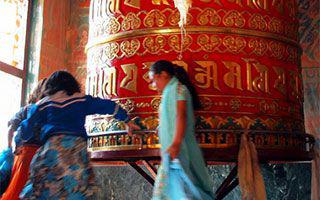Prayer Wheels
Wherever you travel in the Himalayas – from the streets of Lhasa in Tibet to a Mera Peak trek in Nepal – you are likely to find prayer wheels in temples: barrel-shaped, sometimes brightly painted and other times plain metal,

Wherever you travel in the Himalayas – from the streets of Lhasa in Tibet to a Mera Peak trek in Nepal – you are likely to find prayer wheels in temples: barrel-shaped, sometimes brightly painted and other times plain metal, with Tibetan writing circling around them. There are several types of prayer wheels, ranging in size from handheld to larger than cars. Many visitors to the Himalayas wonder what it is they signify and why people dedicate their time to turning wheel after wheel around the boundary of a temple or along a kora (a meditative, holy walk).
The writing on the wheels is typically Buddhist mantras, and it is believed that spinning the wheels will have the same effect as orally reciting the prayers: that is, the accumulation of merit for the person who spins them. The concept of the wheel is also linked to the phrase "turning the wheel of Dharma", which is used to describe the way in which the Buddha taught. The earliest record of prayer wheels dates to around 400 AD, appearing in the writing of a Chinese pilgrim who visited Ladakh. They have since spread throughout the Himalayan region and beyond, so that whether you are on a Mera Peak trek or a Bhutan trek, you will undoubtedly encounter them.
The wheels should be spun clockwise, as this mirrors the movement of the sun across the sky. Some temples may be encircled by smaller wheels than the one pictured above. The route taken should also be clockwise. The mere act of touching a prayer wheel is said to cleanse negative energies from the mind. It is a peaceful act, walking around a temple or kora turning the wheels, and if you get an opportunity – perhaps at a temple in Kathmandu before or after an Annapurna Circuit or Mera Peak trek – we recommend it.
As well as those wheels turned by people, there are wheels built above flowing water in such a way that the water turns them. Upon turning the wheel, the water is believed to be blessed and capable of carrying its purifying power into the lakes and oceans it feeds. There are even some wheels electrically operated and controlled by an internet interface.